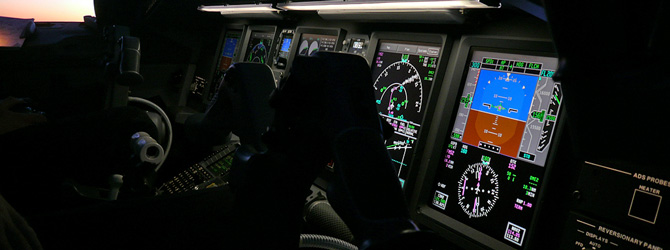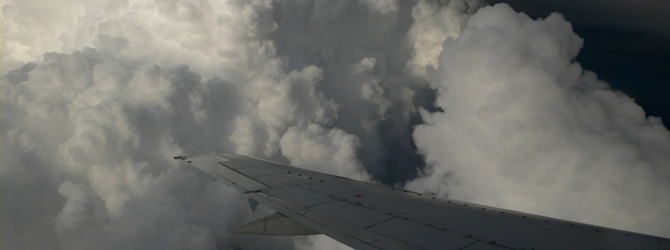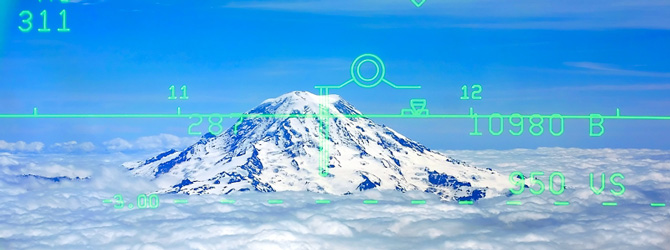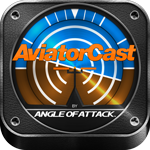
It feels like just yesterday we were all looking at the various analogue flight instruments in our cockpits ensuring everything was within its operational limits. Glass cockpits and automated systems were something straight out of the Jetsons and would be something our grandchildren would see.
My how the times have changed.
Cockpit technology is advancing at a rapid pace, and we have more information at our fingertips than we have ever had before previously. With manufacturers like Garmin and Honeywell cranking out the newest in avionics (at what seems like a ridiculous pace), today we look at the four best features popping up in cockpits around us.
Ground, Can We Get Progressive Taxi?
You’ve navigated halfway across the country, shot an ILS approach to minimums, and turned off the active. You tune the ground frequency only to hear “N1234A, taxi to gate 34 via A, F7, D4, J8, cross runway 07.” You’re at an unfamiliar airport, and you can’t see your hand in front of your face, let alone the taxiway signs. This has all the makings of a classic YouTube video clip and the last thing we want to do is end up like this guy. (Talk about embarrassing.) Quickly pull up the Smart Taxi program on your multifunction display (MFD) and go to work. An airport diagram presents itself, showing your current position, taxiways, even hold short lines and runway incursion hotspots. As you taxi, the map moves along with you (if connected to a GPS) ensuring that you’ll never end up like a certain someone mentioned earlier.
TERRAIN, TERRAIN…PULL UP!
Unfortunately for us, there are days when Mother Nature doesn’t cooperate and throws her worst at us. On those days it’s great to have Synthetic Vision, a tool that provides pilots with a 3D representation of known obstacles in the aircraft’s flight path which proves to be extremely helpful on low visibility days and when flying in mountainous areas. This feature, which can be shown on the Primary Flight Display (PFD) greatly enhances the crews situational awareness. Should the pilot get too close to an obstacle, an aural warning sounds alerting the pilot to the impending danger and allowing he/she time to react appropriately before getting too close for comfort.
Cloudy With A Chance Of…
Living in the Bahamas has its advantages, great beaches, pristine waters, hot sunny days, but one thing is for certain during the summer here; thunderstorms. They are inevitable. Having a great weather radar on board helps navigating on those days when you should really just be curled up in bed. Weather radar can now be brought on your MFD and shown along your flight route depicting the worst areas of the weather allowing you to deviate through the lighter areas. In addition, it shows wind aloft data, wind shear, even lightning strikes. Way cool.
Things That Go tHUD In The Night
Heads Up Displays or HUDS, have been around for years in military use and only in recent years has found its way into civilian cockpits. It provides critical information (airspeed, heading, altitude) all positioned in the pilots line of sight while looking out of the aircraft. It also holds other information such as stall margin indications, landing flare cues, wind shear detection and Traffic Collision Avoidance System TCAS alerts just to name a few. The HUD is especially useful in low visibility operations, allowing pilots to look out of the aircraft without losing pertinent information granting greater situational awareness to the crew. HUDs are now teaming up with Synthetic Vision to provide pilots with even more information, so they can feel fully in command even when the weather isn’t at its best. See how it works here.
As the technology continues to evolve, so will our cockpits, and while learning these new systems and features will take further training, ultimately they can make an industry already known for its remarkable safety record even safer.
This article was posted in Aviation, Blog, Boeing 777, Flight Safety, Flight Simulator, Flightsim Tips, Real World, Technology
Please note: We reserve the right to delete comments that are snarky, offensive, or off-topic. If in doubt, read the Comments Policy.



